
Featured Blog | This community-written post highlights the best of what the game industry has to offer. Read more like it on the Game Developer Blogs or learn how to Submit Your Own Blog Post
Irrational Play and Design
This post explores some of the ways that game designers can benefit from the lessons of behavioral economics.

Introduction
Dan Ariely’s 2009 Ted Talks have accumulated over 3 million views. They captured my imagination and compelled me to read (and love) his book Predictably Irrational. So in early 2013 when I saw that he was teaching an online class through coursera.org, I registered without hesitation. After two weeks of class, I decided to write up how these lessons relate to my experience as a game designer. I’m leaving each week’s material within Prof. Ariely’s outline. I’ll then summarize the main point(s) and relate them to lessons in game design.
Before jumping into the first week’s materials, I’d like to quickly establish the connection between game design and behavioral economics (the subject of Dan’s ted talks, book, and coursera class). The critically acclaimed computer game designer Sid Meier is often quoted for saying that games are a series of interesting decisions. Behavioral economics is focused on how and why people choose to make the decisions that they do. I’m finding that behavioral economics informs both my understanding of how players approach decisions in games, and how I myself am making game design decisions.
Week01: Irrationality
1.1 Visual and Decision Illusions
Decision Illusions: Our brains have evolved to be very good at some things, and quite bad at others. The rational decision making parts of our brains appear to be just as susceptible to falling for illusions as the vision processing parts of our brains. The rest of this course examines different ways in which our decision making faculties can be tricked into making irrational decisions.
Playtest Shield: Playtesting is a cornerstone in game development that is focused on finding divergences between designer expectations and player experiences. However decision illusions can lead both players and game designers to act irrationally. Understanding the limitations of our brains can help inform the design of our playtesting sessions, and help us make sense of their results.
1.2 Defaults
Preference for Defaults: People often prefer to avoid making decisions (especially hard ones). This is one explanation for why organ donation rates correlate so strongly with whether a country uses an opt-out registration forms, and why snail mail response rates are often so low. Despite this, you can probably imagine that very few people attribute their organ donation status to whether they had to opt-in or opt-out of it. Studies show that this preference for defaults generally increases as the complexity or difficulty of a decision increases.
 “Do Defaults Save Lives”, Johnson and Goldstein 2003
“Do Defaults Save Lives”, Johnson and Goldstein 2003
Player Defaults: This is an interesting bias that I am now actively watching for when players take actions in games. As anecdotal evidence, I have seen new players ignore buying cards in the game King of Tokyo (which I consider a great game). I suspect this was due to the work involved in reading the rules on each available card, considering how those rules might effect their chances of winning, and then having to chose between three available options.
Genre Tropes: Designers are every bit as likely to prefer defaults as players, and often without realizing it. Most game designs are naturally influenced by other games. In fact there are entire genres of games that share many common attributes. As soon as your brain connects your original game design to another existing one, you inherit a set of defaults for how each part of your game could work. It’s easy to overlook these subconscious influences, so I encourage you to actively search for design decisions that conform to this kind of default. Then evaluate whether there are any alternatives that might make your game even more compelling.
1.3 Do We Know Our Preferences
Accumulating Decisiveness: In many cases, we are surprisingly unaware of our own preferences. When this happens, we look to our environment for clues about what our preferences and values might be. One example of this is our tendency to follow defaults (as described above). Another example is the effect of being asked to list 3 or 10 things that you like or dislike about something. The relative ease of listing 3 reasons for a preference is likely to help reinforce that preference. Whereas the difficulty in listing 10 reasons for a preference is likely to weaken or even reverse your convictions about that preference.
Suspect Testimony: Although player feedback is one of the most valuable resources you can collect as a game designer, you need to be suspicious of all player testimony. Players won’t necessarily try to lead you astray, but they can be very creative in crafting their own narrative to explain a particular feeling or experience. Try to identify any environmental clues that may bias your players’ responses. And avoid asking leading questions about your game (unless your are trying to impress a publisher instead of improve the quality of your game).
1.4 Choice Sets and Relativity
Decoy Effect: Another environmental clue that our brains extract meaning from is the set of options that we are presented with. If we answer a survey question near one end of a scale or the other, that’s likely to influence our perception of our own relative standing. A more surprising example is when a decision that is typically split 50/50 between two options becomes unbalanced by the addition of a third clearly inferior alternative (that is similar to one of the original options). This is because our brains exaggerate the contrast between the similar choices to make one of the original options (the option that is similar to the inferior choice) more attractive than it was without the seemingly extraneous inferior alternative next to it.
 “The Truth About Relativity”, Dan Ariely
“The Truth About Relativity”, Dan Ariely
Baseline Design: I’ve often heard novice designers comment about making their games more challenging by introducing some form of trickery or confusion. In my experience this rarely helps, on account of how few people enjoy being tricked or confused. Instead, this lesson should serve as a reminder for developers to make sure they provide players with enough information to develop baselines for the comparisons and decision making you expect them to perform. At the same time, developers should be watching for signs that players are consistently making poor estimations.
1.5 The Long-lasting Effects of Decisions
Self Herding: The history of familiar decisions that we’ve already made is another hidden influence on our decision making processes. Although we generally have a good memory for the decisions that we’ve made, our memories are often incomplete in terms of the circumstances that lead us to make those decisions. Each time we make a decision, we inadvertently bias ourselves to make that same decision again in the future. And this effect is fairly independent of otherwise important differences in context and circumstance. In order to help players overcome this bias, game designers need to design clear and timely feedback that directs players’ attention to the contextual differences that explain why one decision may lead to many different outcomes.
High Achievers: Another way I can relate to this self herding phenomena is as a game player. The trial and error mindset that I approach many games with represents a conscious effort to repeat the kinds of decision making that produce positive results. However this often leads to me to a local maxima in terms of skill development. External achievement systems have become a common way for designers to encourage players to experiment with a wider variety of strategies. I certainly hope that designers continue to experiment with ways to more tightly integrate these kinds of incentives into games.
1.6 Learning from our Mistakes
Take Away: Our first week’s lessons conclude very close to where we started. Our brains make a lot of mistakes, and our intuition about how and when those mistakes occur is pretty bad. This understanding should grant us some humility. We should question our intuitions often, and experiment with less intuitive alternatives regularly.
Counter Intuitive Design: In game development, some of this experimentation is built into playtesting. But as designers, we heavily rely on our intuitions throughout the design process. Our intuition is a tool that helps us manage the size of the design space that we work within. It’s a valuable tool to utilize, but one with limitations that require our attention. We need to keep in mind: our preferences for defaults, how easily our decisions can be biased, and the long-lasting effects of the decisions we make. Each of these lessons can make us better game designers.
[Thanks for reading. Please, let me know what you think about this article, if you have questions, and whether you'd like to see more of the material from this class covered in the same way. http://sugarpillstudios.com]
Read more about:
Featured BlogsAbout the Author(s)
You May Also Like








.jpeg?width=700&auto=webp&quality=80&disable=upscale)








